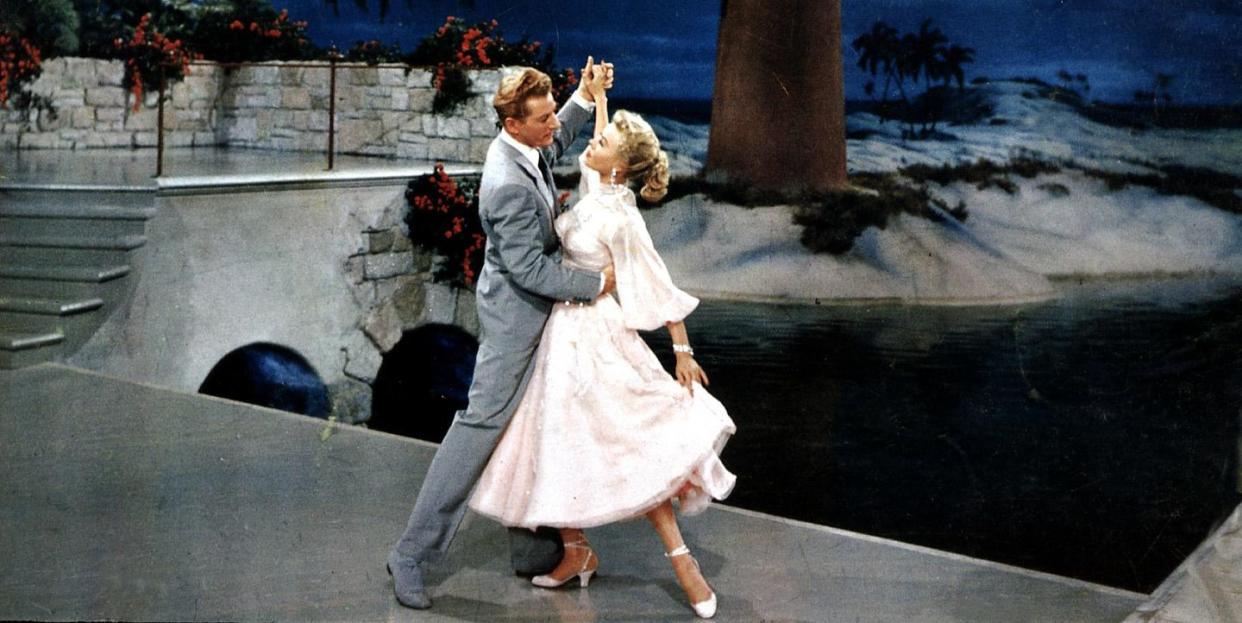Who Are Christmas Movies For?

- Oops!Something went wrong.Please try again later.
What should Christmas look like? In truth, there is no one right answer.
In a holiday movie season increasingly filled with new competition, many of the genre’s biggest players (like Hallmark, Lifetime, and Netflix) are leaning into more inclusive representation that spans races, ethnicities, religions, and sexualities. While heartwarming messages of togetherness, community, and family have not changed, networks and streaming platforms continue to embrace a diverse collection of films filled with characters that connect to an expansive audience hungry for more content to consume.
But not all networks have taken this direction. The recently relaunched GAC Family cable network has explicitly—and lamentably—separated itself from the pack.
Created by Bill Abbott, the former CEO of Crown Media Family Networks (the parent company of Hallmark Channel), and Dallas-based Hicks Equity Partners, GAC Media acquired the Great American Country network, a country music channel, from Discovery, earlier this year. Rebranded as GAC Family, the network says it celebrates “American culture, lifestyle and heritage with holiday-themed, family-friendly original movies and series.”
“GAC is trying to be the conservative channel for people that think Hallmark has turned too liberal. That’s just what it is. Like, the people that don’t want to see LGBTQ representation,” Brandon Gray, co-writer of the book I'll Be Home for Christmas Movies: The Deck the Hallmark Podcast's Guide to Your Holiday TV Obsession and co-host of the popular Deck the Hallmark podcast, tells me. Deck the Hallmark features three men reviewing Hallmark (and the occasional Lifetime and Netflix) Christmas movies. “They’re not going to come right out and say that, but the language is clear.”
So far, this has meant largely white and definitely straight characters in GAC Family programming, raising the important questions: What does it mean to be family friendly? And how are the creators of Christmas and holiday movies working to expand our understanding of family?
Controversy surrounding the GAC Family network was rooted in its origin. In 2019, wedding website Zola.com purchased several commercial spots during the popular Hallmark Channel holiday movie season. The ads featured same-sex couples. However, despite running ads like these on Hallmark since 2017, the 2019 ads were the first to come under fire.
One Million Moms, an advocacy group with possibly only one member, published a highly publicized petition against the commercials. Just 10 days after the new ads began airing, Zola received an email from the Hallmark Channel network saying four of the six spots would be taken off the air due to a violation of the company’s policy on airing “controversial” ads. Later, according to a report from Fast Company, One Million Moms claimed they had spoken with then Crown Media CEO Abbott, who reportedly told the organization that the advertisements had aired in error.
The backlash was swift, from social media users to celebrities to Saturday Night Live. Shortly after, Hallmark reversed its decision and issued an apology. And by early 2020, Abbott had stepped down as CEO, emerging this year with GAC Media’s clear, “family-friendly” programming strategy.
But if family is what you make of it, then so, too, should be our understanding of what makes something family friendly.
Despite the new competition, networks like Lifetime and Hallmark have leaned into more expansive content for viewers. For the Lifetime network, championing diverse and complex representations of family has always been at the forefront of its seasonal “It’s a Wonderful Lifetime” programming.
“Lifetime is a leader in diversity during the holiday season, 100 percent,” the network’s head of programming, Amy Winter, says. Last year, the network released The Christmas Setup, its first Christmas movie featuring two gay cis male romantic leads. “We want everybody to feel like they are welcomed and included, and see themselves in the movies that we offer. Each year, we look to try to expand on that,” Winter says. This year, in addition to numerous films featuring lead actors of various races, the network will premiere its latest LGBTQ-friendly film, Under the Christmas Tree, which features a lesbian romance.
Thankfully, Hallmark is not too far behind. The network debuted its first Christmas movie in 2002, and since then, the network has set the tone for the current-day films. Much like Kleenex or Band-Aid before it, a Hallmark movie is symbolic of a specific type of narrative invented by the brand: one that is warm, bright, nostalgic, and romantic.
But the films’ popularity is not just about the formula; it’s about what the formula represents: togetherness. Deliberately crafting films that are exclusionary goes against the very notion of what makes the films so popular in the first place.
“I think we have continually striven to sort of find new ways to tell stories of family and togetherness,” Lisa Hamilton Daly, Crown Media Family Networks’ EVP of programming, says. “Where can we go? And how can we find as many ways to tell the story of togetherness and connection, and everybody’s holidays?”
Last year’s The Christmas House included a gay male couple (one-half of which being regular Hallmark star Jonathan Bennett). The film’s success has led to a sequel, The Christmas House 2: Deck Those Halls, which premieres December 18 on Hallmark.
According to Daly, this narrative development for its annual “Countdown to Christmas” and “Miracles of Christmas” movie programming block reflects the future of the network. “I see Hallmark growing in an important way of really trying to become more authentic in the stories that are told, just because I think that’s really meaningful to the viewer. It feels more than just a symbolic ad if it feels like we see you, we see your culture, we see what you’re bringing to the table,” Daly says.
Only one GAC Family film, Christmas Time Is Here, features two straight Black leads (Dewshane Williams and Rukiya Bernard, the latter of whom has appeared in Hallmark Christmas movies in the past). In terms of content, most GAC Family films stick to a straight-and-white formula.
Other GAC films for this holiday season include familiar Hallmark faces, like Cameron Mathison who stars in A Kindhearted Christmas with Beverly Hills, 90210’s Jennie Garth. Mathison hosted Hallmark’s now-defunct daily talk show Home & Family until its cancellation in August. Lori Loughlin will also make her unceremonious return in When Hope Calls: A Country Christmas. The film is based on the series When Hope Calls, a spin-off of the former Hallmark network show When Calls the Heart, which also starred Loughlin (although, she was dropped after the 2019 college admissions bribery scandal). Further Hallmark stars, like Danica McKellar, have signed exclusive deals with the network, though no reason was given for their departure.
So what qualifies as family-friendly? After rightfully being fired by Hallmark for her involvement in a nationwide admissions scheme, Loughlin has been given a second chance on a network that calls itself “family friendly.” One can (and should) argue that the morally reprehensible outside actions of someone like Loughlin are far less “friendly” or appropriate for families than content that may feature diverse yet good-natured characters.

And more importantly, an exclusionary and archaic view of what makes a family is one that has never been fully embodied by all Americans. Families have always been non-white and non-straight. They have always had single parents or no parents at all. They have always encompassed different faces and histories and lifestyles. Family, as most of us have come to know it, is not determined by how well it conforms to a particular structure, but by the strengths of its bonds and its lineage of origin. What makes something unsuitable for a family should not be based on the real, lived, and unharmful identities of race, class, religion, or sexuality that we all embody in contrasting ways.
GAC Family network does a real disservice both to the fanatic viewers of holiday movie fare and, more broadly, the increasingly diverse population within the United States. What is a “Great American Country” if not the acceptance rather than the rejection of the sort of differences that make this country so unique?
“When we have expanded into new areas, it’s just delightful for people to feel like, ‘Look, that could be me, that could be my sister, that could be somebody from my family [that] is finally represented,” Winter says. “And we’ve been doing this for years. You just see America represented in the way that it should be.”
The content we consume can be a mirror for what we hold dear in real life. In 2021, that should mean the fullness—not the narrowness—of our humanity.
Update: A GAC media spokesman has responded to this piece with the following statement: “GAC Media is absolutely committed to diversity and gender equity, on screen, behind the camera and throughout our company’s workforce. Our current programming slate features actors representing diverse backgrounds in leading and supporting roles, and we are creating a strong pipeline of diverse talent for GAC Family and GAC Living original content.”
You Might Also Like

